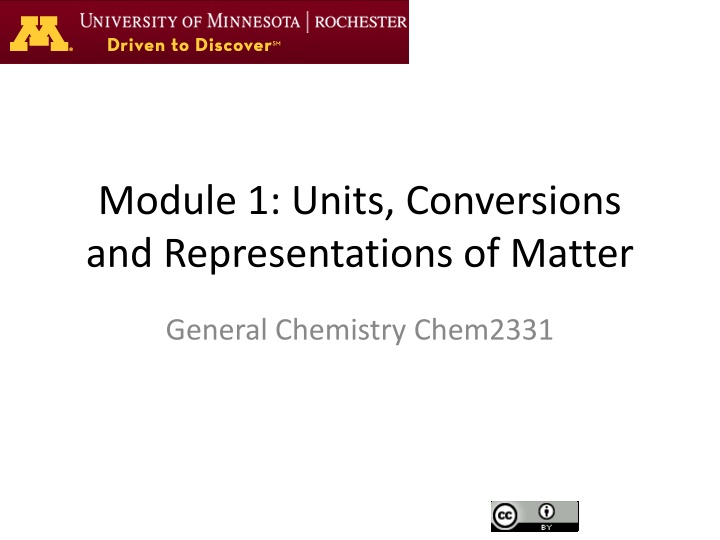
Units, Conversions, and Representations in Chemistry
Explore the world of chemistry with a focus on units, conversions, and various representations of matter. Learn about the metric system, exponential and scientific notations, and different ways to visually represent chemical substances at a submicroscopic level. Dive into the symbolic language used in chemistry to understand both macroscopic and sub-microscopic phenomena.
Download Presentation

Please find below an Image/Link to download the presentation.
The content on the website is provided AS IS for your information and personal use only. It may not be sold, licensed, or shared on other websites without obtaining consent from the author. If you encounter any issues during the download, it is possible that the publisher has removed the file from their server.
You are allowed to download the files provided on this website for personal or commercial use, subject to the condition that they are used lawfully. All files are the property of their respective owners.
The content on the website is provided AS IS for your information and personal use only. It may not be sold, licensed, or shared on other websites without obtaining consent from the author.
E N D
Presentation Transcript
Module 1: Units, Conversions and Representations of Matter General Chemistry Chem2331
Outline Module 1. Video 1. 1. Representations in Chemistry 2. Exponential and scientific notations 3. Metric and SI system 4. Conversion between metric system 1. Linear conversions 2. Square conversions (surface) 3. Cube conversions 4. Conversion of combined units: density Chem 2331: General Chemistry 2
Representations in Chemistry We can t see the atomic world. Too small, too fast. We need representations. H2O Symbolic Quantitative: Numbers and letters Atomic Macroscopic Qualitative: (submicroscopic) Diagrams or graphs Experienced with senses mass, density, concentration, pH, T We need pictures to understand Chem 2331: General Chemistry 3
Representations in Chemistry The symbolic language can express both, macroscopic and sub-microscopic phenomena H2O(l) H2O(s) NaCl(s) + H2O(l) NaCl(aq) macro H2O H+ + OH- Na-Cl + H2O Na-Cl-OH2 sub-micro Chem 2331: General Chemistry 4
Representations in Chemistry We have many ways to represent the submicroscopic world: Draw a submicroscopic representation of 1-chloropropane In organic chemistry there s a grey area between symbolic and submicroscopic Chem 2331: General Chemistry 5
Exponential and Scientific Notation Fixed Decimal or fixed notation: A drop of water contains about 1,520,000,000,000,000,000,000 molecules. An atom of neon has a radius of about 0.000 000 007 centimeters. Exponential notation: A drop of water contains about 1.52 x 1021molecules. An atom of neon gas has a radius of about 7.0 x 10-9centimeters. Calculators don t use superscript. Instead they use E: A drop of water contains about 1.52E21 molecules. An atom of neon gas has a radius of about 7.0E-9 centimeters. Scientific notation: a particular case of exponential notation In scientific notation, the decimal point in the significant must be after the first digit that is not a zero. 0.0152 x 1023 = 0.152 x 1022 = 1.52 x 1021 = 15.2 x 1020 = 152.0 x 1019 Chem 2331: General Chemistry 6
Review 3x10-5 * 3*105 = 3x10-5 + 3*105 = 3x10-5 / 3x105 = Chem 2331: General Chemistry 7
The Metric System and SI units SI Base Units are a selection of the metric units Physical Quantity (Dimension) Unit Abbreviation Unit Name mass kilogram kg length meter m time second s temperature kelvin K electric current ampere A amount of substance mole mol luminous intensity candela cd Chem 2331: General Chemistry 8
Metric prefixes Scientific Notation and Prefixes Prefix Symbol Conventional Notation 1,000,000,000,000 1x1012 1,000,000,000 1x109 1,000,000 1x106 1,000 1x103 Prefix Word Exponential Notation tera giga mega kilo hecto deka ----- deci centi milli micro nano pico femto T G M k h da ---- d c m m n p f trillion billion million thousand hundred ten one tenth hundredth thousandth millionth billionth trillionth quadrillionth 100 1x102 10 1x101 1 1x100 0.1 1x10-1 0.01 1x10-2 0.001 1x10-3 0.000001 1x10-6 0.000000001 1x10-9 0.000000000001 1x10-12 0.000000000000001 1x10-15 Activity: A typical ballpoint pen is 15 cm long. How long is this in meters and in millimeters (mm) and in micrometers ( m)? Chem 2331: General Chemistry 9
Conversion Factors between the metric system A pack of 10 pairs of socks cost $3 How much does 2 pairs of socks cost? Write this calculation using factor conversion desired unit = given unit desired unit given unit Using units as a guide to problem solving is called dimensional analysis You can do the same kind of operations on units as you can with numbers 2cm 3cm = 2x3 cm2 = 6 cm2 2cm + 3cm = 5cm 2cm 3cm = 0.66 (no units) Chem 2331: General Chemistry 10
Conversion Factors between the metric system Conversion between the metric system Convert 10-3 kg into mg Chem 2331: General Chemistry 11
Conversion Factors between the metric system Length Surface Volume In m2 1x106 1x104 1x102 1x100 1x10-2 1x10-4 1x10-6 1x10-8 1x10-10 1x10-12 In m3 1x109 1x106 1x103 1x100 1x10-3 1x10-6 1x10-9 1x10-12 1x10-15 1x10-18 In m 1x103 1x102 1x101 1x100 1x10-1 1x10-2 1x10-3 1x10-4 1x10-5 1x10-6 =1km2 =1km3 =1km =1hm2 =1hm3 =1hm =1dam2 =1dam3 =1dam =1m2 =1m3 =1m =1dm2 =1dm3 =1dm = 1 L =1cm2 =1cm3 =1cm = 1 mL =1mm2 =1mm3 =1mm = m = m2 = m3 Chem 2331: General Chemistry 12
Conversion Factors between the metric system Convert 2 cm2 into m2: Convert 10-3 dm3 into m3 Chem 2331: General Chemistry 13
Conversion of combined units. Density: mass / volume Convert 2 g/mL into g/m3 Chem 2331: General Chemistry 14





















